what will happen to musks tesla in space
SpaceX has completed the last crucial pace of Falcon Heavy'due south countdown test flight afterward successfully launching Elon Musk'southward Tesla Roadster out of Earth'due south orbit, on a trajectory into deep space. But what will happen to the car and 'Starman' every bit information technology makes its long journey to Mars? Let united states explore the details.
Although Elon Musk indicated that the Tesla had been placed in an orbit that would nearly extend to the beginnings of the solar system'southward first asteroid belt (on average more 150 million miles away from World'due south orbit), SpaceX updated that orbit estimate about 24 hours later on and confirmed that the orbit was considerably closer to Mars' orbit than the asteroid belt beyond the Red Planet.

Starman gives one final cheerio to Earth as he departs for deep infinite aboard Musk'southward Tesla Roadster. (SpaceX)
Understandably, the ultimate destination and state of the Roadster have been the source of an array of questions from those less familiar with interplanetary travel and orbital mechanics – nearly people.
How exactly does infinite travel piece of work?
Before delving into the details, it'south crucial that I try to give everyone equal footing in the class of a basic understanding of what, how, and whensof spaceflight. To reach orbit, Falcon Heavy launched its Tesla payloadhorizontally. Once it rose vertically above the majority of Earth'due south atmosphere, the rocket angled over until it was essentially thrusting parallel to World'due south surface. Think of it similar spinning a brawl on a cord: merely after a sure speed will the ball successfully spin in a circle – spin too slow and the ball will simply fall. Reaching Globe orbit is very similar in concept: Falcon Heavy boosts the upper stage above Globe'south atmosphere, and the upper stage ignites and gains as much horizontal speed every bit possible.
All this time, both it and its Tesla payload are being pulled downwardly past Earth'south gravity, only at a certain speed (8 kilometers per second, or ~18,000 mph), the rocket and its payload stop up going faster around the Earth than its gravity can pull them down. A famous analogy tin can be constitute in a uncomplicated tennis ball: thrown normally, the ball will arc over and eventually fall to the basis. Yet, if a ball is thrown fast enough (and was also able to avert existence incinerated by friction against the atmosphere), one tin can imagine the ball going over the horizon, traveling around the Globe, and coming right back to the thrower.

Elon Musk walks among his recovered Falcon Heavy boosters at LZ-i and 2. (Elon Musk)
Throwing a ball (or spaceship) into orbit
Amazingly, this becomes a far more reasonable proposition when dealing with asteroids, comets, and moons with much calorie-free gravity than Earth's "1G." For instance, on Mars' tiny moon Phobos, an astronaut could very nearly escape from the moon byrunning, and could virtually effortlessly throw a ball fast enough to orbit Phobos (a blistering 25 mph would be required). Globe is merely like that, just much, much, much larger, and with a thick atmosphere that both keeps usa, humans, alive and also makes it quite a bit more than difficult for us to get into orbit.
Dorsum to Globe orbit. The first point of stability (when you are going faster forward than the Earth can pull you lot down) is called "low Earth orbit," (LEO) being roughly the lowest elevation and velocity necessary to stably orbit the Earth. This is approximately where the International Space Station (ISS) is located (~ 250 miles above). Famously, astronauts and satellites at this altitude travel around the Earth once every 90 minutes, half in pure sunlight, one-half in the darkness of Globe's own shadow – essentially a special sunrise and sunset every three-quarter of an hour.

Mars' largest moon Phobos captured at the border of the planet's limb. Phobos is less than 15 miles in diameter. (ESA/Mars Limited)
At present, expand that model of Earth and the Roadster in orbit around information technology to the unabridged solar system. In this model, Globe and all other objects are orbiting the Sun at unlike distances and speeds, like different bands of the aforementioned tree ring. The solar system is massive, however, and thus everything has to exist scaled up: for example, the Earth orbits the Sun at30 kilometers per second (~70,000 mph), nearly four times faster than our apprehensive Tesla in LEO.
Remember: when orbiting Earth, objects are even so under the firm concur of the planet's gravity, just just moving then fast that they are in a constant state of freefall. Take away the air, and beingness on the ISS is akin to skydiving, simply if the skydive never ended. To trulyescape Globe'southward gravity and caput to the Moon, Mars, or beyond, a rocket needs to get even faster still. In the case of the Roadster, this meant first speeding upwardly to 8 km/s to reach a stable orbit effectually Globe, followed several hours later by 1 terminal burn that gave the payload another 3-four km/south of speed. On the calibration of the solar system, Roadster's journey abroad from Earth tin be thought of similar, well, a Roadster making its fashion to the top of a steep loma. Later on climbing to the top, the Roadster is almost out of energy but has just enough to accelerate as information technology begins its style down the other side. About six hours afterward launch, the rocket'due south upper phase successfully crested the summit of Earth'due south gravitational loma earlier rocketing down the other side, on its way to deep space, Mars, and beyond.
In essence, the rocket moved Musk'southward Tesla from an orbit around World to an orbit around the Sunday itself. But as Earth takes 365 days (a year) to travel once around the Sun, the Roadster will complete an orbit of the sun every once in awhile, likely closer to the two Earth years it takes for Mars to complete its orbit. Similarly, evidenced by Earth and all the other planets in the solar arrangement, orbiting the sun is typically very stable – humans do not exactly alive in fearfulness of the Earth falling into the sun, we simply continue going around and around. Like the planets, Musk'south Roadster will almost certainly remain in its current orbit for millions of years – mayhap even a billion years – quietly completing an orbit around the sun every 2 or and then years for what is finer an eternity on a human scale. Eventually, information technology'southward possible that the Roadster and Starman will be pulled over time by the gravity of Earth in such a mode that it reenters Earth's temper and burns up, but that is unlikely to happen for thousands of millennia.
Where is the Roadster headed?
The graphic tweeted by Musk serves as a skilful initial explanation of complex terms used to describe orbital mechanics. Because it is not circular, the orbit is known equally elliptical,while the points closest to (perihelion) and furthest from (aphelion) the Sun also have their special names. TheAU mentioned in the graphic refers toastronomical units,a standard measurement based upon the boilerplate distance between the Earth and the Sun – approximately 93 million miles. For comparison, a full trip around the Earth'due south equator is a little less than 25,000 miles. Space is unfathomably immense.
Third burn successful. Exceeded Mars orbit and kept going to the Asteroid Belt. pic.twitter.com/bKhRN73WHF
— Elon Musk (@elonmusk) February vii, 2018
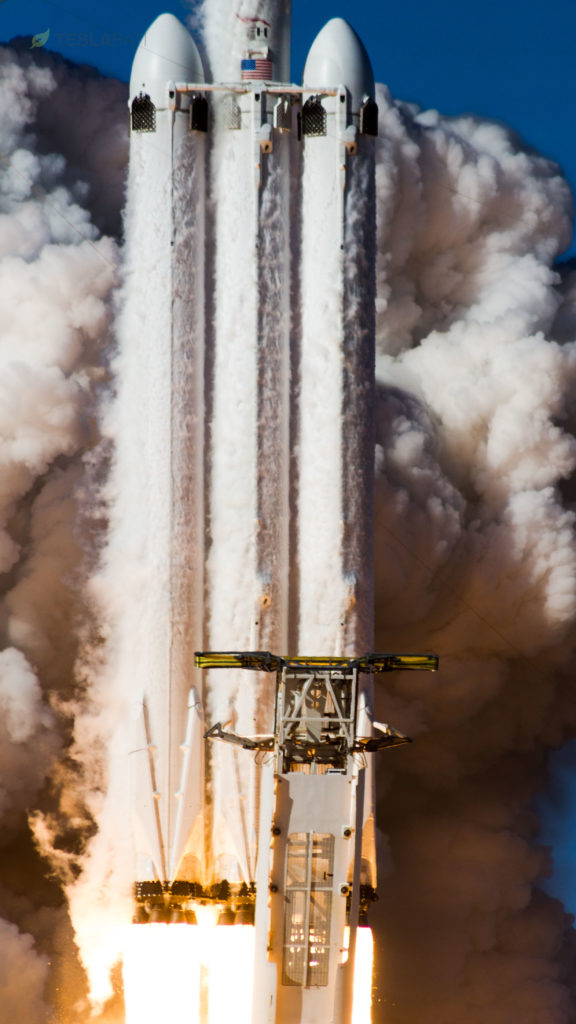
Falcon Heavy explodes off of Pad 39A in a spectacle of burn, Roadster in tow. (Tom Cross)
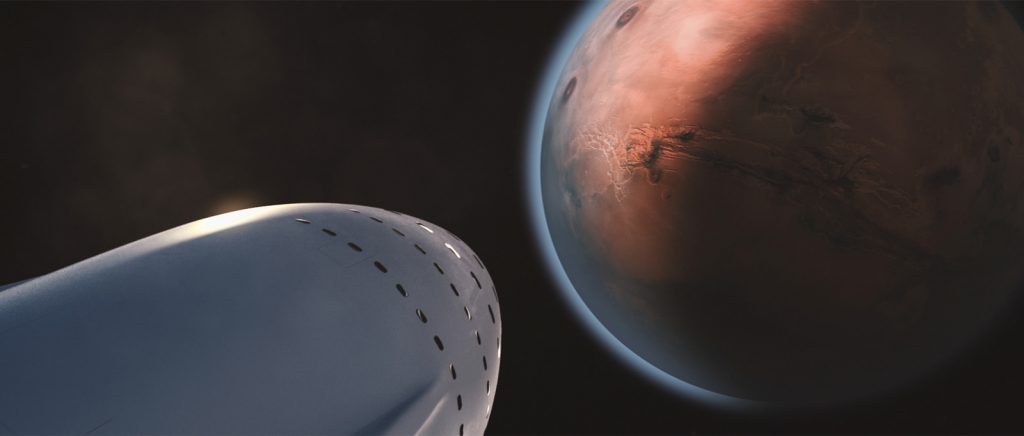
The Roadster's orbit will accomplish out on one end equally far as Mars, SpaceX's ultimate destination as a visitor. (SpaceX)
Falcon Heavy's upper stage appears to have simply burned until it ran out of fuel, and managed with the far end of its orbit at about 1.61 astronautical units (~250 million km) is considerably less than Musk's pre-launch press conference suggestion that the Roadster was expected to end up in an orbit of 380 to 450 meg kilometers.
Musk: If the 3rd burn goes as nosotros hope, the Tesla will get as far abroad as 380 to 450 1000000 km from Globe.
— Eric Berger (@SciGuySpace) February v, 2018
Is the Roadster going to Mars?
Sadly, the answer is a hard "no." At about, the Tesla might have been sent into an orbit effectually the sun (heliocentric orbit) with a very shut approach to Mars – a flyby, so to speak. It appears that SpaceX managed to get quite close to that original goal, and it is entirely possible that Starman'south Roadster could pass shut to Mars at points forth its orbit, although at that place will exist no fashion to capture or transmit images from the Roadster.

While there will be no cameras to capture it, it looks like Starman could actually – one day – pass close to the Red Planet on his billion year journey. (SpaceX)
Peradventure most chiefly, to launch the Roadster into such a high orbit, SpaceX had to ensure that the rocket's upper stage could coast for multiple hours in Earth orbit and still be able to precisely reignite its Merlin Vacuum (MVac) engine for a last burn down. By successfully accomplishing precisely that, SpaceX has taken a huge step towards existence able to compete with the United Launch Alliance forall government and defense-related launch contracts, fifty-fifty those requiring direct placement into geostationary orbit (GEO), versus a slower but more than common geostationarytransferorbit (GTO). Not coincidentally, that capability also means that SpaceX can efficiently send payloads beyond Earth orbit, as they have now washed for the beginning fourth dimension with Musk's Tesla Roadster.
How long will it take?
Because the Roadster is not actuallygoing to any planets, moons, or asteroids, information technology will never reach them. However, the electric car's newfound orbital home means that it will at least be far, far from Earth – at points, it's trajectory will cross closest to the orbits of Mars and Earth. It will take a minimum of several months for the Roadster to reach those distances, even at its blistering speed of 12 kilometersper second relative to World. Jonathan McDowell, a practicing astronomer, estimated that the Roadster would pass Mars orbit – to be clear, not arriving at Mars, simply reaching the aforementioned distance away from the Lord's day as Mars orbits – in July 2018, approximately five months from today.
Corrected orbital information for the Roadster: 0.99 ten one.71 AU x 1.1 deg
C3 = 12.0, passes orbit of Mars Jul 2018, aphelion November— Jonathan McDowell (@planet4589) February 8, 2018
What'southward going to happen to Starman and the Roadster?
Soaring through the difficult vacuum of deep infinite, not a whole lot tin can be expected to happen to Elon Musk'due south Tesla Roadster and Starman. As mentioned, the loftier heliocentric orbit it was placed in volition be incredibly stable, likely allowing the automobile to remain in deep space for tens of millions of years. Now, that is not to say that future human explorers millions of years from now would recognize whatever remained – deep space is characterized by a relatively extreme radiation environment that volition not exist kind to many components that make upward the Roadster's structure. Carbon fiber, plastic, leather, and paint all contain organic components that volition exist assaulted by an environment far harsher than that in and effectually Earth.
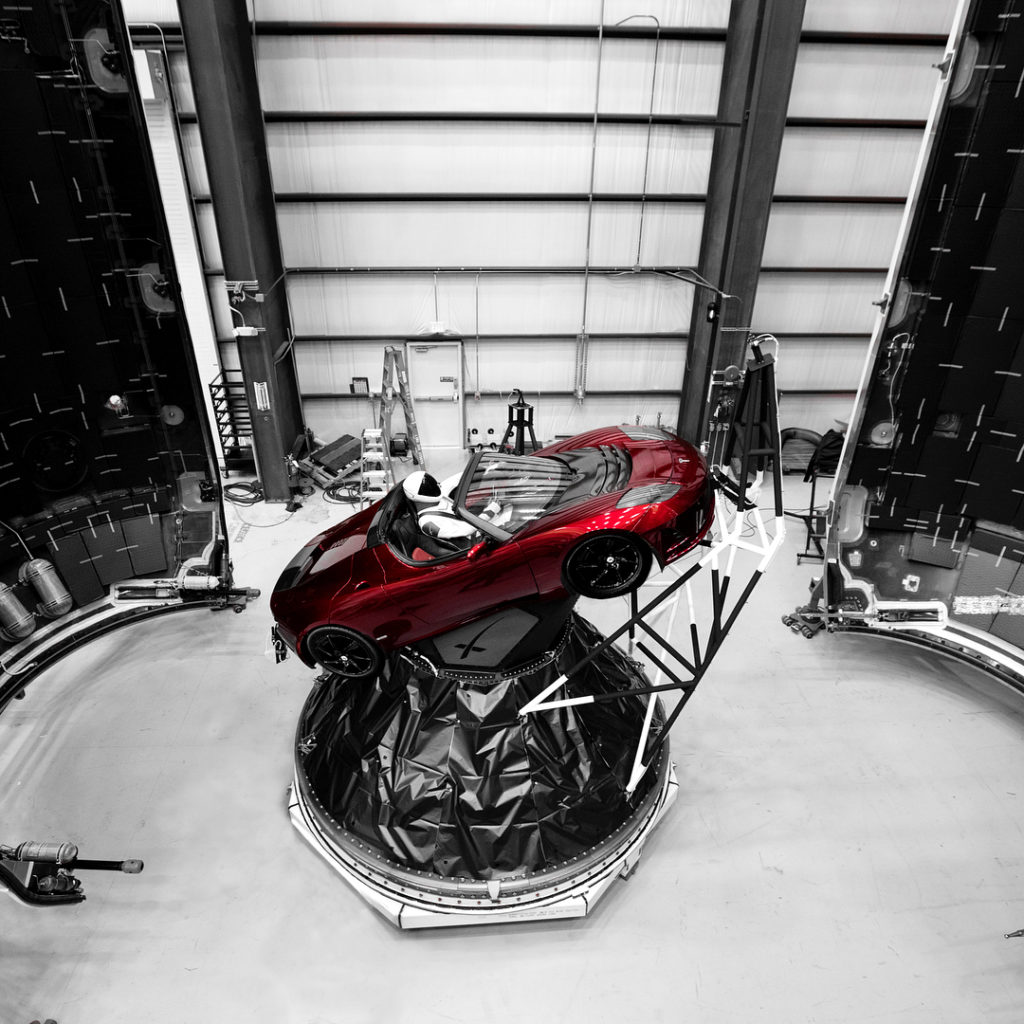
Elon'southward Tesla Roadster and his astronaut stand-in. (Elon Musk)
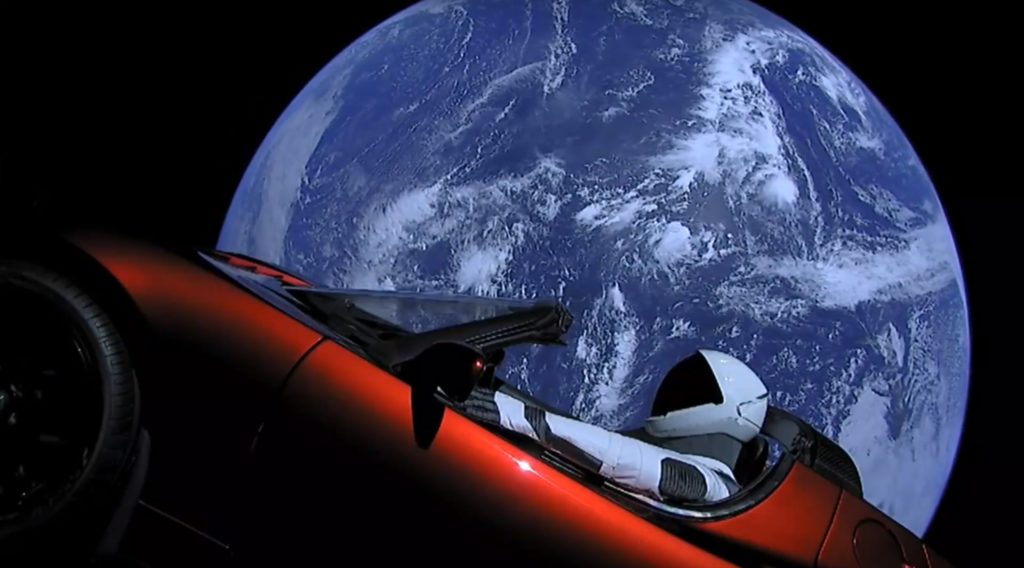
. . . . . . . . yep. This is a affair, now. (SpaceX)
Still, hyperbolic claims that "Radiation Will Tear Elon Musk's Rocket Car to Bits in a Year" are ridiculously exaggerated. Vacuum is characterized by the absence of annihilation, and that includes all conceivable methods of erosion. While loftier energy radiation found in deep space can and probable will shred the Tesla'southward structural integrity and eventually bleach or discolor the car, the Roadster will be perfectly suspended in microgravity (basically zilch gravity) conditions with nearly no chance whatsoever of impacts by even tiny infinite debris like micrometeorites. If an aspiring auto collector tried to recover the eccentric and historic trophy from space in several centuries/millennia, Roadster would very likely fall to pieces or even crumble to dust when moved or placed in an environment with any significant gravity. Just, it will about without a doubt retain its recognizable shape almost indefinitely, at least on a human calibration. Starman tin can be expected to react very similarly.
hyperbolic claims that "Radiation Will Tear Elon Musk'due south Rocket Car to $.25 in a Yr" are ridiculously exaggerated.
Finally, it appears that SpaceX has not installed any method of power generation or advice on Starman's ride, significant that humans likely saw their last views of the vehicle after SpaceX cut the alive feed to Starman. This sadly ways that at that place will be no photo ops with Starman soaring by Mars or exploring the asteroid belt, although that selection will certainly be reserved for whatever future eccentric, Muskian examination payloads.
Why does sending a car into deep space matter?
Ultimately, this final success is an invaluable cherry on height of what was already a stunning achievement. Without a single scrubbed launch attempt or unintended concur during the last countdown, SpaceX'southward first launch of what is now the almost capable operational rocket in the earth was a perfect success in almost all regards. Although the massive rocket's center booster failed to state aboard the drone ship Of Form I Still Dear Yous (OCISLY) due to an apparent shortage of the chemical components used to reignite the booster's engines, both side boosters were recovered on land with what can only be described as well-oiled expertise. Meanwhile, the rocket but survived the launch in general, didn't destroy the pad, successfully tested its unproven side booster separation mechanism, and launched an eccentric payload into the highest orbit nevertheless achieved by the commercial launch company.
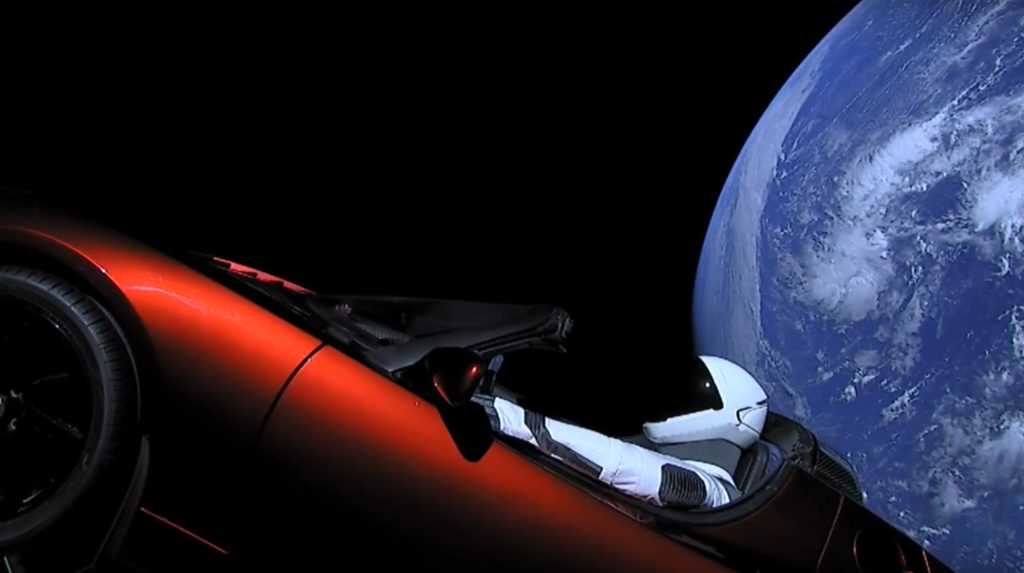
It'due south easy to understand why Musk himself laughed about Roadster looking very much similar CGI. (SpaceX)
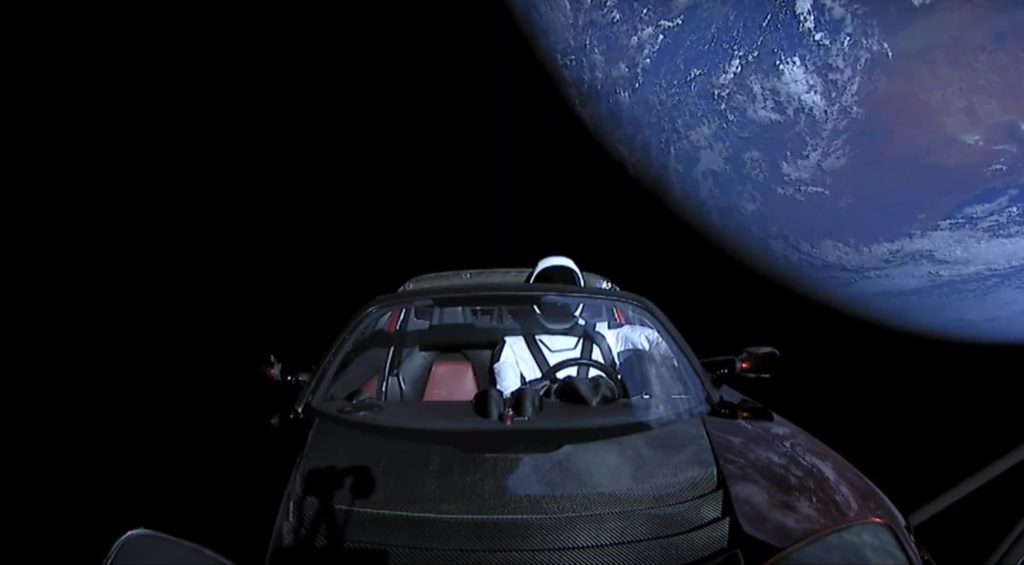
Is this existent life? Who knows anymore. (SpaceX)

. . . . . . . . yes. This is a thing, now. (SpaceX)
In the case of Elon Musk, it certainly appears that it is possible to – at least once and awhile – have one's cake and eat information technology too. Follow along alive as launch photographer Tom Cross and I cover these exciting proceedings as close to live every bit possible.
Teslarati – Instagram – Twitter
Tom Cross – Twitter
Eric Ralph– Twitter

Source: https://www.teslarati.com/what-happen-elon-musk-tesla-space-journey-mars/
0 Response to "what will happen to musks tesla in space"
Post a Comment